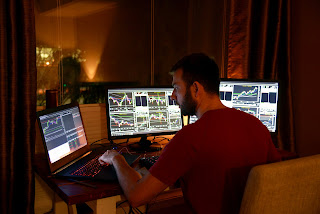Using the DeMarker Indicator to Identify Potential Market Tops and Bottoms
The DeMarker Indicator, also known as the DeM, is a technical analysis tool that compares the current price action of a financial instrument with its price action over a specified time period. It was developed by Tom DeMark, a market technician and founder of Market Studies, LLC. The DeM is used to identify potential market tops and bottoms, as well as potential trend reversals.
The DeM is calculated using the following formula:
DeM = (Hn - Ln) / (Hp - Lp)
where Hn is the current period's highest price, Ln is the current period's lowest price, Hp is the previous period's highest price, and Lp is the previous period's lowest price.
The DeM oscillates between 0 and 1, with readings above 0.7 indicating overbought conditions and readings below 0.3 indicating oversold conditions. A reading above 0.7 is generally considered a sell signal, while a reading below 0.3 is generally considered a buy signal.
One of the main advantages of the DeM is that it is a leading indicator, meaning it can provide early signals of potential trend reversals. This is because the DeM is sensitive to changes in price momentum, which often precede changes in price direction.
To use the DeM, traders can apply it to a chart and look for divergences between the DeM and price action. For example, if the price of a financial instrument is making new highs, but the DeM is not, this could be a bearish divergence and a potential sell signal. Similarly, if the price of a financial instrument is making new lows, but the DeM is not, this could be a bullish divergence and a potential buy signal.
Traders can also use the DeM in conjunction with other technical indicators, such as moving averages or the relative strength index (RSI), to confirm potential signals. For example, a bearish divergence between the DeM and price action could be confirmed by a bearish crossover between moving averages or a reading of overbought conditions on the RSI.
In addition to divergences, traders can also look for trend line breaks on the DeM as potential signals. For example, if the DeM is in an uptrend and breaks below a trend line, this could be a bearish signal. Similarly, if the DeM is in a downtrend and breaks above a trend line, this could be a bullish signal.
It's important to note that the DeM is not a standalone indicator and should be used in conjunction with other technical and fundamental analysis tools. Additionally, like all technical indicators, the DeM is not perfect and can generate false signals. Therefore, traders should always use risk management techniques, such as stop-loss orders, to protect against potential losses.
In conclusion, the DeMarker Indicator is a technical analysis tool that compares the current price action of a financial instrument with its price action over a specified time period. It is used to identify potential market tops and bottoms, as well as potential trend reversals. To use the DeM, traders can look for divergences between the DeM and price action, confirm potential signals with other indicators, and look for trend line breaks on the DeM. However, the DeM should be used in conjunction with other analysis tools and risk management techniques should always be employed to protect against potential losses.




Comments
Post a Comment